Un modello sistemico delle relazioni tra azienda, biodiversità ed ecosistemi per gestire la performance ambientale
Titolo Rivista MANAGEMENT CONTROL
Autori/Curatori Lino Cinquini, Giacomo Pigatto, Andrea Tenucci, Niccolò Braico
Anno di pubblicazione 2024 Fascicolo 2024/2
Lingua Italiano Numero pagine 25 P. 161-185 Dimensione file 380 KB
DOI 10.3280/MACO2024-002008
Il DOI è il codice a barre della proprietà intellettuale: per saperne di più
clicca qui

FrancoAngeli è membro della Publishers International Linking Association, Inc (PILA)associazione indipendente e non profit per facilitare (attraverso i servizi tecnologici implementati da CrossRef.org) l’accesso degli studiosi ai contenuti digitali nelle pubblicazioni professionali e scientifiche
Biodiversity loss and ecosystem collapse are major threats to humankind’s wellbeing and companies are facing increasing attention – and normative pressure – to consider their impacts on and dependencies from biodiversity and ecosystems. However, it is not easy to understand the complex relation-ship occurring between business activities, biodiversity, and ecosystems. Therefore, this research constructs a systemic model to comprehend such a re-lationship and breaks it up into simpler and manageable components. The re-search adopts an interventionist methodology in which the researchers under-took a literature review followed by focus groups with experts and companies to co-develop the systemic model. The final model identifies and classifies sixteen types of impacts that companies have on biodiversity grouped into five main drivers: ecosystem use change, over-exploitation, invasive alien species, pollution, and climate change. Moreover, the model identifies and classifies twenty-four ecosystem services grouped into three main categories: provisioning services, maintaining and regulating services, and immaterial and cultural services. This research contributes to management control re-search and practice by proposing a model that could help companies valuing, managing, monitoring, and accounting for a complex phenomenon – the rela-tionship between companies, biodiversity, and ecosystems – by breaking it up into simpler, clearer, and more manageable components.
Parole chiave:Biodiversity, Ecosystem, Impact, Dependency, Interventionist Re-search, Systemic Model
Lino Cinquini, Giacomo Pigatto, Andrea Tenucci, Niccolò Braico, Un modello sistemico delle relazioni tra azienda, biodiversità ed ecosistemi per gestire la performance ambientale in "MANAGEMENT CONTROL" 2/2024, pp 161-185, DOI: 10.3280/MACO2024-002008